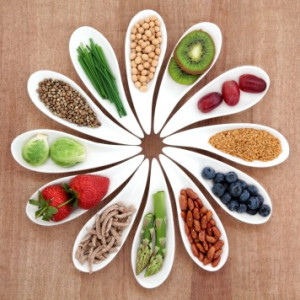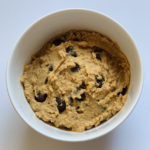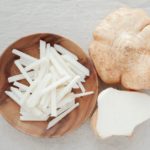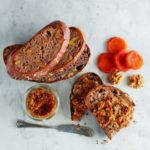
Eating high-fiber foods for kids can be a great way to keep our bodies feeling satisfied, strong, and healthy.
So, what exactly is fiber? And how can you find the best fiber foods for kids? Dietary fiber is a type of carbohydrate that adds bulk to the diet. It also aids with digestion and helps maintain regular bowel movements. Did you know that eating a high-fiber diet can help lower inflammation and prevent weight gain?
Dietary fiber is essential for a healthy gut because it nourishes beneficial bacteria. Inadequate fiber intake can lead to an overgrowth of harmful bacteria, which may damage the intestinal lining. When this happens, proteins from food can leak through and trigger immune responses and manifest as food sensitivities. (1, 2).
Fiber-rich foods for kids are typically lower in calories and full of foods that make you feel full faster.
What is Fiber- Definition for Kids
Fiber comes in two forms: soluble (dissolves in water) and insoluble (does not dissolve in water). Most plants contain both soluble and insoluble fiber, but the amount of each type varies in different plant foods. While both types are important, they have very different effects on your health.
Insoluble Fiber
When most people think about fiber foods for kids, their minds automatically go to the “roughage” found in most fruits, vegetables, and whole grains. This type of fiber is insoluble. Insoluble fiber “sweeps through the colon like a broom,” adding bulk to your stool, giving it a much-needed push that helps clean away the residue left by other foods. (3).
This type of fiber:
- Prevents constipation and diarrhea
- Decreases risk for:
- Colon cancer
- Varicose veins, hemorrhoids, and diverticulitis
- Obesity
- Food high in insoluble fiber includes wheat bran, nuts, cruciferous vegetables, and more
Fiber-rich foods provide many short- and long-term health benefits for kids.
Soluble Fiber
Soluble fiber is just as important as insoluble fiber and can be found in foods like oats, apples, peas, and beans. Soluble fiber absorbs water (draws water into the gut) and creates bulk in the stools, allowing them to pass more easily. It also helps: (3)
- Reduce cholesterol
- Decrease risk for:
- Heart disease
- Osteoporosis
- Cancers like breast and bone
- Diabetes
- Food high in soluble fiber includes beans, peas, oat bran, barley, and more
Because there are so many health benefits to fiber, the average person should make it a goal to eat at least 25 grams of fiber per day. Many children do not get enough fiber. Find out how much fiber per day your kids need using my guide!
What Foods Are High in Fiber for Kids?
Fiber can be found in plant foods like whole grains (whole wheat spaghetti, quinoa, oatmeal), nuts (almonds, pistachio, and chia seeds) beans (lentils, pintos, lima), and fruits (raspberries, prunes, blackberries), and vegetables (green peas, artichokes, sweet potato). When increasing fiber intake, it is equally important to drink plenty of water to stay hydrated and push fiber-rich foods through the body.
Follow the MyPlate example
According to the USDA MyPlate guidelines on healthy eating and portion sizes, half of our plate should be filled with fruits and vegetables, a quarter should be whole grains, and the other quarter should be protein. This means that ideally, three-quarters of your plate should contain fiber-rich foods!
Fiber Foods For Kids: Pay Attention to Food Label
It can be difficult to know if the foods you eat are high in fiber, which is why reading the food label is helpful. Before you purchase “granola” or “wheat” products, check the food label and make sure that the product contains fiber. Aim for 3-5g or more of fiber per serving.
You can also read the ingredient list to make sure the first word listed is “whole,” as in whole grain or whole wheat. Products sometimes claim to be “wheat” or “enriched” but are still missing the part of the grain that is beneficial to the body. You can also look for products labeled “100% whole wheat.”
Fiber-Rich Foods For Kids
So, what are the best fiber foods for kids? Here are a few tasty ideas of where to look for fiber.
- Eat more Fruits and Vegetables: These foods are packed with insoluble fiber, and they contain other important nutrients that are vital to health, too. By including 4-5 servings of vegetables and 2-3 servings of fruit in your meals and snacks each day, you can be on your way to meeting your needs. Try to keep the skins of fruits and vegetables on to reap the most benefit.
- Look for Whole Grains: Refined grains like white bread contain little to no fiber. An easy way to make sure you are getting enough fiber is to buy 100% whole grain bread, cereals, rice, tortillas, or pastas. Whole grains may taste a little different than their refined counterparts, but once you start including these slightly nutty-tasting grains in your diet, you may never go back! Aim to make at least half (ideally 75%) of the grains you eat whole grains. Have fun with these healthy whole grain activities for kids.
- Add Seeds to Your Diet: Chia seeds and ground flaxseeds are packed with fiber, and you can add them to foods you already eat! Toss chia seeds into smoothies or combine them with milk or yogurt to make a chia pudding. Add a tablespoon of ground flaxseed to yogurt or oatmeal in the morning, or stir some into your favorite muffin, pancake, or waffle batter.
Fiber-Rich Foods For Kids: Tasty Recipes
You can also make delicious fiber-rich recipes featuring fruits, vegetables, whole grains, legumes, and nuts or seeds! We’ve included a few of our favorites.
1. Chickpea Cookie Dough
This recipe is a great higher-fiber alternative to traditional cookie dough because of the whole chickpeas included in it! Taste-test both versions to see which one your family prefers.

2. Jicama Sticks with Guacamole
Jicama is a tasty high-fiber vegetable that makes a great snack! Pair it with guacamole for a dip with extra flavor and fiber from the avocado.

3. Nutty Cinnamon Fruit Spread
Serve this delicious spread with whole-wheat toast for a delicious high-fiber breakfast or snack!

Fiber Food for Kids: Rethink fast food
Fast food lacks fiber, and a lot of the greasy, fried options can cause digestive distress. If fast food is the only option, seek out choices like apple slices or carrot sticks with dip, oatmeal, and salads with dressing on the side. You can also try asking for a whole-grain bun or tortilla. Try to always carry a quick fiber-rich snack with you, like nuts, popcorn, or a piece of fruit. That way, you can prevent overdoing it at the fast food stops.
Test Your Knowledge
What kind of fiber is found in most fruits and vegetables? What are the benefits of this type?
- Insoluble fiber is found in fruits and vegetables; it prevents diarrhea and constipation and reduces the risk of colon cancer, obesity, hemorrhoids, diverticulitis (4), and varicose veins.
When buying wheat products, what words should you look for in the ingredient list?
- Look for the words “whole wheat, oats, spelt” or “whole grain” and make sure that the product has enough fiber to be considered a good source.
According to MyPlate, how much of the plate should be fruits and vegetables? How much should be grains and protein?
- MyPlate recommends that half of your plate be filled with fruits and vegetables, a quarter filled with grains, and a quarter with protein.
References:
- Zhang Y-J, Li S, Gan R-Y, Zhou T, Xu D-P, Li H-B. Impacts of Gut Bacteria on Human Health and Diseases. International Journal of Molecular Sciences. 2015; 16(4):7493-7519. https://doi.org/10.3390/ijms16047493
- Caminero, A., Meisel, M., Jabri, B. et al. Mechanisms by which gut microorganisms influence food sensitivities. Nat Rev Gastroenterol Hepatol 16, 7–18 (2019). https://doi.org/10.1038/s41575-018-0064-z
- Eye on Nutrition: Fiber. WIC Works Resource System. https://wicworks.fns.usda.gov/resources/eye-nutrition-fiber
- a W, Nguyen LH, Song M, et al. Intake of Dietary Fiber, Fruits, and Vegetables and Risk of Diverticulitis. Am J Gastroenterol. 2019;114(9):1531-1538. doi:10.14309/ajg.0000000000000363
This article was updated in February 2025 from its original publish date in June 2015.












